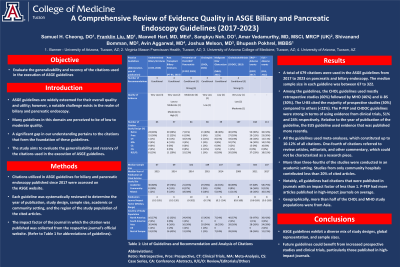Monday Poster Session
Category: Interventional Endoscopy
P2791 - A Comprehensive Review of Evidence Quality in ASGE Biliary and Pancreatic Endoscopy Guidelines (2017–2023)
Monday, October 28, 2024
10:30 AM - 4:00 PM ET
Location: Exhibit Hall E

Has Audio

Franklin Liu, MD
Banner - University of Arizona
Tucson, AZ
Presenting Author(s)
Samuel H. Cheong, DO1, Franklin Liu, MD1, Maxwell Hart, MD, MEd1, Sangkyu Noh, DO1, Amar Vedamurthy, MD, MSCI, MRCP (UK)2, Shivanand Bomman, MD3, Avin Aggarwal, MD4, Joshua Melson, MD3, Bhupesh Pokhrel, MBBS1
1Banner - University of Arizona, Tucson, AZ; 2Virginia Mason Franciscan Health, Tucson, AZ; 3University of Arizona College of Medicine, Tucson, AZ; 4University of Arizona, Tucson, AZ
Introduction: ASGE guidelines are widely esteemed for their overall quality and utility; however, a notable challenge exists in the realm of biliary and pancreatic endoscopy. Many guidelines in this domain are perceived to be of low to moderate quality. A significant gap in our understanding pertains to the citations that form the foundation of these guidelines. The study aims to evaluate the generalizability and recency of the citations used in the execution of ASGE guidelines.
Methods: Citations utilized in ASGE guidelines for biliary and pancreatic endoscopy published since 2017 were accessed on the ASGE website. Each guideline was systematically reviewed to determine the year of publication, study design, sample size, academic or community setting, and the region of the study population of the cited articles. The impact factor of the journal in which the citation was published was collected from the respective journal’s official website. (Refer to Table 1 for abbreviations of guidelines).
Results: A total of 679 citations were used in the ASGE guidelines from 2017 to 2023 on pancreatic and biliary endoscopy. Among the guidelines, the CHOL guidelines used mostly retrospective studies (60%) followed by MHO (46%) and U-BS (30%). The U-BS cited the majority of prospective studies (30%) compared to others (< 22%). The P-PEP and CHDOC guidelines were strong in terms of using evidence from clinical trials, 51% and 24% respectively. All the guidelines used meta-analyses, which constituted up to 10-12% of all citations. One-fourth of citations referred to review articles, editorials, and other commentary, which could not be characterized as a research piece. The median sample size in each guideline was between 67 to 322. Relative to the year of publication of the guideline, the EUS guideline used evidence that was published more recently. More than three-fourths of the studies were conducted in an academic setting. Studies from only community hospitals contributed less than 20% of cited articles. P-PEP had more articles published in high-impact journals on average. Notably, all guidelines had citations that were published in journals with an impact factor of less than 1. Geographically, more than half of the CHOL and MHO study populations were from Asia.
Discussion: ASGE guidelines exhibit a diverse mix of study designs, global representation, and sample sizes. Future guidelines could benefit from increased prospective studies and clinical trials, particularly those published in high-impact journals.
Note: The table for this abstract can be viewed in the ePoster Gallery section of the ACG 2024 ePoster Site or in The American Journal of Gastroenterology's abstract supplement issue, both of which will be available starting October 27, 2024.
Disclosures:
Samuel H. Cheong, DO1, Franklin Liu, MD1, Maxwell Hart, MD, MEd1, Sangkyu Noh, DO1, Amar Vedamurthy, MD, MSCI, MRCP (UK)2, Shivanand Bomman, MD3, Avin Aggarwal, MD4, Joshua Melson, MD3, Bhupesh Pokhrel, MBBS1. P2791 - A Comprehensive Review of Evidence Quality in ASGE Biliary and Pancreatic Endoscopy Guidelines (2017–2023), ACG 2024 Annual Scientific Meeting Abstracts. Philadelphia, PA: American College of Gastroenterology.
1Banner - University of Arizona, Tucson, AZ; 2Virginia Mason Franciscan Health, Tucson, AZ; 3University of Arizona College of Medicine, Tucson, AZ; 4University of Arizona, Tucson, AZ
Introduction: ASGE guidelines are widely esteemed for their overall quality and utility; however, a notable challenge exists in the realm of biliary and pancreatic endoscopy. Many guidelines in this domain are perceived to be of low to moderate quality. A significant gap in our understanding pertains to the citations that form the foundation of these guidelines. The study aims to evaluate the generalizability and recency of the citations used in the execution of ASGE guidelines.
Methods: Citations utilized in ASGE guidelines for biliary and pancreatic endoscopy published since 2017 were accessed on the ASGE website. Each guideline was systematically reviewed to determine the year of publication, study design, sample size, academic or community setting, and the region of the study population of the cited articles. The impact factor of the journal in which the citation was published was collected from the respective journal’s official website. (Refer to Table 1 for abbreviations of guidelines).
Results: A total of 679 citations were used in the ASGE guidelines from 2017 to 2023 on pancreatic and biliary endoscopy. Among the guidelines, the CHOL guidelines used mostly retrospective studies (60%) followed by MHO (46%) and U-BS (30%). The U-BS cited the majority of prospective studies (30%) compared to others (< 22%). The P-PEP and CHDOC guidelines were strong in terms of using evidence from clinical trials, 51% and 24% respectively. All the guidelines used meta-analyses, which constituted up to 10-12% of all citations. One-fourth of citations referred to review articles, editorials, and other commentary, which could not be characterized as a research piece. The median sample size in each guideline was between 67 to 322. Relative to the year of publication of the guideline, the EUS guideline used evidence that was published more recently. More than three-fourths of the studies were conducted in an academic setting. Studies from only community hospitals contributed less than 20% of cited articles. P-PEP had more articles published in high-impact journals on average. Notably, all guidelines had citations that were published in journals with an impact factor of less than 1. Geographically, more than half of the CHOL and MHO study populations were from Asia.
Discussion: ASGE guidelines exhibit a diverse mix of study designs, global representation, and sample sizes. Future guidelines could benefit from increased prospective studies and clinical trials, particularly those published in high-impact journals.
Note: The table for this abstract can be viewed in the ePoster Gallery section of the ACG 2024 ePoster Site or in The American Journal of Gastroenterology's abstract supplement issue, both of which will be available starting October 27, 2024.
Disclosures:
Samuel Cheong indicated no relevant financial relationships.
Franklin Liu indicated no relevant financial relationships.
Maxwell Hart indicated no relevant financial relationships.
Sangkyu Noh indicated no relevant financial relationships.
Amar Vedamurthy indicated no relevant financial relationships.
Shivanand Bomman indicated no relevant financial relationships.
Avin Aggarwal indicated no relevant financial relationships.
Joshua Melson indicated no relevant financial relationships.
Bhupesh Pokhrel indicated no relevant financial relationships.
Samuel H. Cheong, DO1, Franklin Liu, MD1, Maxwell Hart, MD, MEd1, Sangkyu Noh, DO1, Amar Vedamurthy, MD, MSCI, MRCP (UK)2, Shivanand Bomman, MD3, Avin Aggarwal, MD4, Joshua Melson, MD3, Bhupesh Pokhrel, MBBS1. P2791 - A Comprehensive Review of Evidence Quality in ASGE Biliary and Pancreatic Endoscopy Guidelines (2017–2023), ACG 2024 Annual Scientific Meeting Abstracts. Philadelphia, PA: American College of Gastroenterology.
